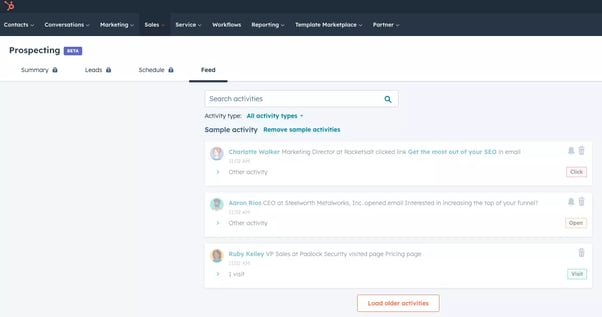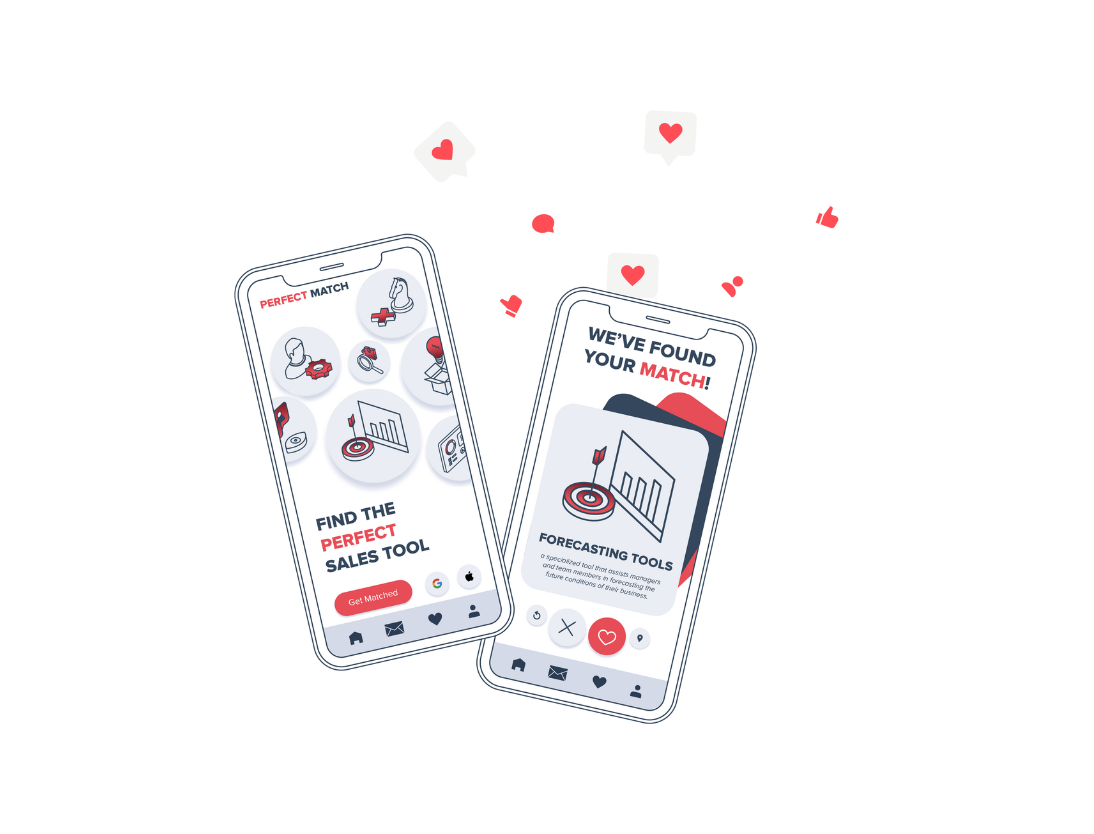In this article, we explore how sales enablement, also known as revenue enablement, is changing and how to use technology to increase revenue.
With the rise of digital platforms and the increasing preference of B2B buyers for online interactions, the traditional methods of sales are undergoing a significant transformation.
This means that as a business, you need to adapt and align your strategies with these changing preferences.
But how can you ensure that you’re not just keeping up but excelling in this new environment?
The changing dynamics of sales enablement
Sales enablement leaders today face a variety of challenges. From economic disruptions and talent scarcity to supply chain issues, the hurdles are many. Moreover, a significant shift is being observed in the market.
A growing number of B2B buyers now prefer a self-service experience. This doesn't mean that the role of a sales representative is becoming obsolete. Instead, it highlights the importance of equipping sales teams with the right tools and strategies to engage buyers with a highly personalised approach.
But what does this self-service experience entail? It's an environment where buyers have all the information they need at their fingertips, allowing them to make informed decisions without always needing a sales rep to guide them.
This shift is a testament to the power of digital transformation and the importance of sales enablement tools in aiding relationship building.
Seller effectiveness: The backbone of sales enablement
Every successful sales strategy hinges on the effectiveness of its sellers. And in the age of digital sales, this effectiveness is closely tied to three key areas:
- Content management: You’ve no doubt heard that content is king. But it's not just about having content; it's about having the right content. Sales teams need access to relevant, up-to-date, and engaging sales enablement content that resonates with their target audience. With the right content management tools, sales reps can ensure they're always equipped with the materials they need to engage and persuade potential buyers.
- Sales readiness: Being ready isn't just about being prepared for a sales pitch. It's about having the right tools, knowledge, and strategies at your disposal. Sales readiness tools empower sales teams, ensuring they're always equipped to handle any sales scenario. From training modules and mock sales scenarios to real-time feedback and analytics, these tools ensure that sales reps are always at the top of their game.
- Sales coaching: Continuous improvement is the name of the game. With the right sales coaching tools, businesses can provide their sales teams with regular feedback, training, and guidance. This not only helps in improving sales strategies but also ensures that sales reps are always aligned with the company's broader objectives.
Buyer engagement: Creating lasting impressions
In the world of sales, first impressions matter. But these days, every interaction is an opportunity to create a lasting impression. Engaging buyers effectively is no longer just about the initial pitch; it's about the entire journey.
- Creating "wow" moments: In a saturated market, standing out is crucial. This is where the "wow" factor comes into play. It's about going above and beyond, offering solutions that not only meet but exceed the buyer's expectations. Whether it's through personalised content, interactive demos, or real-time assistance, creating these moments can make the difference between a missed opportunity and a closed deal.
- Ensuring ease of doing business: The modern buyer values convenience. They're looking for seamless experiences, quick responses, and straightforward processes. Sales enablement tools play a pivotal role here, streamlining operations and ensuring that buyers can easily navigate through the sales process. From AI-powered chatbots that provide instant answers to platforms that simplify documentation, the right tools can significantly enhance the buyer's experience.
Revenue optimisation: Maximising sales potential
With the right sales enablement strategies and tools in place, businesses can not only engage buyers effectively but also optimise their revenue potential. This is where revenue optimisation tools come into the picture, offering insights, analytics, and solutions that drive sales success.
- Revenue intelligence: In the world of sales, data is invaluable. Revenue intelligence tools harness this data, providing insights that can improve win rates and reduce sales cycle duration. By analysing past sales data, market trends, and buyer behaviour, these tools offer actionable insights that can significantly enhance sales strategies.
- Conversation intelligence: Every conversation with a potential buyer is an opportunity to learn. Conversation intelligence tools record, transcribe, and analyse these interactions, offering invaluable insights into buyer preferences, pain points, and potential objections. This not only helps in refining the sales pitch but also in training and coaching sales reps.
- Pipeline management and forecasting: Predicting future sales trends is crucial for any business. With the right pipeline management and forecasting tools, businesses can track potential leads, monitor sales progress, and predict future trends. This not only helps in allocating resources effectively but also in strategising for future growth.
Adapting to the changing role of sellers
The role of sales representatives is evolving. With the rise of digital platforms and the shift towards a self-service experience, sellers need to adapt to remain relevant.
- Virtual selling skills: In today's remote-first world, virtual selling skills are no longer optional. Sales reps need to be adept at engaging buyers through digital platforms, ensuring that the experience is as effective as face-to-face interactions.
- Addressing challenges: Sellers today face numerous challenges, from market saturation to evolving buyer preferences. Sales enablement tools can provide the necessary support, offering insights, training, and resources to navigate these challenges successfully.
- Continuous improvement: The sales landscape is dynamic, and to stay ahead, continuous improvement is essential. Regular feedback, training sessions, and access to the latest tools and resources can ensure that sales reps are always at the top of their game.
The crucial role of technology in sales
Digital transformation has reshaped the sales landscape, making technology an indispensable ally for sales teams. However, with the wide variety of tools available, it's essential to choose the ones that align with the company's goals and the needs of the sales team.
- Challenges with technology: While technology offers numerous advantages, many sellers find it overwhelming. The key is to integrate tools that simplify processes rather than complicate them. Sales enablement leaders must ensure that the tech stack is user-friendly, efficient, and adds genuine value to the sales process.
- The power of buyer engagement tools: In an era where buyers are more informed and have higher expectations, engagement tools can bridge the gap. These tools, ranging from AI-driven chatbots to interactive demos, ensure that the buyer's journey is smooth, informative, and memorable.
- Simplified workflows with essential technologies: The right technology can streamline workflows, reduce manual tasks, and ensure that sales reps can focus on what they do best – selling. Integrating CRM systems, analytics platforms, and automation tools can significantly enhance efficiency and productivity.
Choosing the right sales enablement software
Navigating the vast sea of sales enablement software can be daunting. With so many options available, how can businesses ensure they're making the right choice? Here's a guide to help you select the best tools for your needs:
- Understand your needs: Before diving into the market, take a step back and assess your needs. Are you looking to improve content management, enhance buyer engagement, or optimise revenue? Identifying your primary objectives will help narrow down your options.
- Integration capabilities: A tool is only as good as its ability to integrate seamlessly with your existing systems. Whether it's your CRM, marketing platforms, or analytics tools, ensure that the sales enablement tool can easily integrate, ensuring a smooth workflow.
- User-friendliness: A tool that's complicated or not intuitive can hinder productivity. Opt for tools that are user-friendly, offer a clean interface, and require minimal training.
- Scalability: As your business grows, your needs will evolve. Choose a tool that can scale with your growth, offering more advanced features and capabilities as your requirements change.
- Feedback and reviews: Look for feedback from other businesses in your industry. Reviews, testimonials, and case studies can provide valuable insights into the tool's effectiveness and reliability.
- Customisation: Every business is unique, and so are its needs. A tool that offers customisation options can be tailored to fit your specific requirements, ensuring maximum efficiency.
- Cost-effectiveness: While it's essential to invest in quality tools, it's equally crucial to ensure you're getting value for money. Compare features, capabilities, and prices to ensure you're making a cost-effective choice.
- Support and training: A tool is only as effective as its implementation. Opt for providers that offer robust support, training sessions, and resources to ensure your team can make the most of the tool.
- Future-proofing: The world of sales is dynamic, and tools need to keep up. Ensure that the tool you choose is regularly updated, incorporates the latest trends, and is future-proof.
- Security: Last but certainly not least, ensure that the tool prioritises data security. With sensitive sales data being processed, it's crucial to choose a tool that offers robust security measures.
By considering these factors and conducting thorough research, businesses can ensure they're equipping their sales teams with the best tools to drive success.
Using HubSpot to transform your end-to-end sales process
Using powerful software like HubSpot’s Sales Hub Enterprise arms your sales team with easy-to-use tools to assist them with sales enablement. By linking to HubSpot’s Marketing Hub and Service Hub, Sales Hub Enterprise gives your sales team a greater chance of converting marketing leads to customers and helps your CRM team manage relationships going forward.
With Sales Hub Enterprise, connecting with prospects has never been easier. The platform gives you access to templates, sequences, tasks, email scheduling, canned snippets, documents, and more, to maximise the efficiency of your team's outreach.
Also, features like standardised reporting and lead analysis, sales content optimisation, automatic lead rotation, automated email sequences, sales enablement software and website visit notifications give salespeople on-the-fly data about prospects so they can close them quicker.
The top 10 HubSpot sales enablement tools
In the world of sales enablement, having the right tools can make all the difference. HubSpot offers a suite of tools designed to empower sales teams, streamline processes, and enhance buyer engagement.
Let's explore our favourite sales enablement tools that HubSpot Sales Hub offers:
1. Prospecting tool
This tool enables users to track task completion, meetings scheduled, sequence performance, and more, all within a single dashboard.
Use cases:
- One-stop shop for sales reps to track their productivity and availability
- Coaching tool for sales managers to review individual activity

2. Sequences
HubSpot's Sequences tool offers an automated series of emails and tasks. It allows for pausing actions until the previous action is complete and provides performance analytics.
Use cases:
- Outreach automation
- Alternative to workflow automation, providing sales team members with greater control over process flow
- Sales email testing and optimisation
3. Forecast/goals
HubSpot provides tools to forecast revenue attainment and growth for teams and individuals, and submit forecasts for review.
Use cases:
- Resource planning
- Goal development and tracking for lead and lag metrics
4. Meetings
HubSpot's meeting tools allow users to schedule meetings directly from the contact record, create various scheduling pages, and track meeting types and outcomes. As of the latest update, it also includes the ability to route meetings via forms and the scheduling of meetings on behalf of others.
Use cases:
- Meeting tracking and conversion
- Inbound meeting scheduling
- Team scheduling pages
- Outcome-based automation
5. Templates and snippets
HubSpot offers the ability to create personalised, customisable, structured email templates, and text shortcuts for use in emails and notes.
Use cases:
- Intro emails
- Next step/follow-up emails
- Prospecting emails
- Frequently used links
- Email intros and outros
- Standardised notes
6. Playbooks
HubSpot's playbooks allow users to create interactive content cards to standardise note-taking and create resource guides.
Use cases:
- Note-taking and property value capture
- Scripting
- Link banks
- Resource guides with text, video, and links
7. Documents
HubSpot's document feature allows for document upload and tracking. Users can create unique sharing URLs and track engagement and performance over time, such as when the recipient has opened a document, how much time they spent on it, who they forwarded it to and which pages they spent the most looking at.
Use cases:
- Sales brochures
- Case studies
- Whitepapers
- Demo decks
- Comparative Analysis documentation
8. Quotes & products
HubSpot offers a customisable quote tool with e-signature capability, along with a product library for efficient quote creation. It also allows for the sent quotes to be tracked, deals automatically moved to the next stage when signed, and automatic follow-up reminders to be sent.
Use cases:
- Custom quote and product creation
- Quote tracking and automation
9. Calling
HubSpot's calling feature boasts click-to-call functionality, call recording & transcription, call forwarding, and both inbound/outbound call capabilities. It also integrates conversation intelligence to glean insights from calls.
Use cases:
- Improving call volume
- Tracking inbound and outbound calls
- Call review and coaching
10. Coaching playlists
HubSpot allows users to curate a playlist of the best call recordings, serving as a valuable resource for future coaching sessions.
Use cases:
- Call review and coaching
- Onboarding for new sales reps

Who benefits from sales enablement tools?
Any company looking to grow its customer base through sales should have Inbound-focused sales enablement practices in place.
Having a clear idea of why, when and how your sales team sells products and services to prospects helps to convert the right leads at the right time. It also ensures a higher probability of those prospects becoming customers.
To achieve this, marketing and sales must work together to create a strategy that retains and maintains the interest of potential customers. That said, what tools can help in the process?
Align sales and marketing goals with an interactive lead goal calculator
While marketing bread-and-butter strategies like blog posts, whitepapers, case studies, and other forms of content excel at building awareness and generating leads, they rarely close deals on their own. For that, you need a driven sales team equipped with lead-generating content.
But what types of content should you be creating for your sales team? And how can you make sure they use it? Let’s delve deeper.
Content for lead generation
If your content is generating leads, wouldn’t you want your sales reps to know as much about that content as possible? Wouldn’t you want them to know what kinds of leads the content is generating, including the topic of the content and its likely audience?
Of course! Having this knowledge will give your sales reps more context and help them to nurture leads and close sales more frequently.
For this reason, you should always share your content with your sales team. The easiest way to give them access to this content would be to create a library that contains all of the latest collateral. Once they have access, they can share that content via email or LinkedIn to reach potential prospects.
Here are a few examples of content that helps your sales team to generate leads:
1) Question-based content
One of the best ways to create blog content is to listen to the questions your customers ask.
And the easiest way to find out what questions are being asked is to ask your sales reps.
These blogs work incredibly well because they immediately address the concerns of existing customers and potential prospects. Your salespeople can readily share these assets via social media or email and get in front of the right people.
2) Gated content
Likewise, when marketing and sales don’t communicate, there’s a good chance the primary mechanism for lead generation (whitepapers and eBooks) will miss the mark. By regularly consulting with your sales team, you can help ensure that this doesn’t happen.
Focus on creating gated content that provides insights that cannot be found elsewhere or tackles a specific problem your prospects and/or customers have in incredible detail.
3) Case studies
Salespeople love to have good references to share with prospects, so make sure to refresh your case study library regularly.
Content for internal sales support
Sales teams are often underprepared when it comes to garnering the interest of a potential customer. To mitigate this, it’s worth investing time in the following:
1) Sales scripts
There’s nothing worse than a salesperson who reads a script line-by-line to a prospect. That said, you do want your sales team to hit the right conversation points during a sales call. Creating sales scripts that are similar to ‘talking points’ will go a long way towards making your reps sound more like humans and less like parrots.
2) Product sheets
This is another asset that’s useful for both the sales rep and the prospect — the product sheet.
This piece of content should answer at least some of the following questions:
-
Who is the product for?
-
What does it do?
-
How does it help?
-
How much does it cost?
Having a readily available sheet that lists your brand’s core products and services is essential for any initial meeting with a prospect.
3) Competitor comparisons
Sales reps should be aware of what the competition is offering and how their brand can differentiate itself. It’s important to understand why your company is the best and summarise this information in an easy-to-view format. With this kind of collateral, your sales team will increase their conversion odds significantly.
Content for sales conversions
As noted, not all sales content is meant to stay in-house. Here are some examples of content that should be delivered by the sales team itself:
1) Emails
Apart from the company newsletter, a marketing department will want to equip its sales team with templates for several different occasions.
There should be follow-up emails, outreach emails, check-in emails, and more. Ideally, a canned email should exist for every type of customer or prospect interaction.
2) One-pagers
This form of sales collateral is a fast and easy way for prospects to view what services the brand provides and whether or not the brand's product can solve their pain point.
3) Presentations
Customer slide decks should always be a joint production. When marketing does it all, the content can miss the mark in terms of what drives conversions. When sales do it all, the decks often lack context and consistency. While marketing should take the lead in generating this content, they must do so with heavy input from sales.
4) Social messages
Although social media isn’t immediately thought of as a sales tool, sales reps need to interact with prospects via social media, so be sure to provide them with some suggested tweets and LinkedIn messages.
The fact is that in today’s world, social selling has become an integral part of the modern sales process. Providing your sales reps with tools to reach out, monitor conversations and target potential prospects or partners via social media is crucial.
Where to focus your resources and energy
Ultimately, the content produced by your marketing department must serve the business. The best way to ensure this happens is by focusing more of your energy on creating content that’s geared towards the sales department.
The HubSpot CRM automates the nagging tasks that distract sales reps from selling. It is the ultimate customer relationship-building tool, allowing reps to get an up-to-the-minute view of their entire sales funnel on a clean, visual interface.
How Huble can help you find the right sales enablement tools
In the ever-evolving world of sales, staying ahead requires a combination of the right sales enablement strategies, tools, and mindset.
As you navigate the challenges and opportunities of the digital age, sales enablement tools emerge as a key driver for success.
At Huble, we understand the intricacies of the sales landscape. Offering expert sales consultancy services, we empower sales teams with the right tools and strategies to excel.
If you're looking to transform your sales enablement processes and achieve unparalleled commercial success, speak with our team to learn more.















